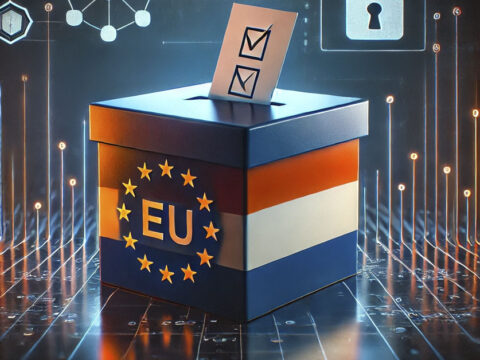End in Sight for Dutch Blockchain Coalition
End in Sight for Dutch Blockchain Coalition
Ecosystem in Place; Next Few Years Will Reveal if Technology is Here to Stay
After seven years, the Dutch Blockchain Coalition (DBC), a partnership between the government, knowledge institutions, and the business sector, will conclude at the end of this year. The final conference took place on July 1 at TU Delft. According to the coalition, the objectives have been met. The conference also highlighted new, related initiatives, such as the Broad Analysis Tokenization and the international public-private partnership ‘Fides – Accelerating Digital Trust’.
The mission of the DBC was to increase knowledge about and use of blockchain to accelerate the decentralized setup of the digital infrastructure in the Netherlands. The coalition worked with an action agenda to test the technological possibilities of blockchain, ensure the technology aligns with laws and regulations, and develop research and training programs in this field.
According to Victor van der Hulst, coalition manager of the Dutch Blockchain Coalition, the primary reason for ending the coalition is the general achievement of its goals. “There is now an active ecosystem in the Netherlands, strategic dialogue with policymakers and companies has taken place, and the technology is present and being incorporated into laws and regulations.” In the coming months, ongoing activities will be concluded, the acquired knowledge and experiences will be secured, and a final report will be prepared.
Digital Key Technology
Another practical reason for the coalition’s end is the cessation of government subsidies, which, along with partner contributions, were the main sources of income for the Dutch Blockchain Coalition. These subsidies were facilitated by the Top Sector ICT, which brought together public and private parties to collaborate on key technologies. Until 2024, blockchain was one of these digital key technologies, and in the revision of the National Technology Strategy, it has been categorized under the key technology ‘Software Technologies and Computing’.
Van der Hulst: “Such key technology has a temporary character. As a coalition, we then had to consider what our role should be in the coming years and whether the existing ecosystem is strong enough to handle this independently.”
Shouting from the Rooftops
Despite the progress, blockchain has faced enough criticism over the years. Not everyone is convinced of its added value. The cryptocurrency hype, controversial cryptomining, and failures of projects like the prestigious Tradelens—a blockchain-driven global trade platform set up by IBM and container carrier Maersk—have not helped its popularity.
Van der Hulst acknowledges that the blockchain community sometimes overhyped the technology. “But that is part of a young technology. You need to give it time. In the mentioned failed projects, the technology was not the cause, but rather the governance and/or business model. This is often the challenge with a decentralized setup, which is too easily underestimated.”
“Van der Hulst Has Great Confidence in Initiatives Around Smart Contracts and Self-Sovereign Identity”
He also points out that blockchain is not a ‘push technology’ that you can use directly but is part of an application area involving various technologies. In this regard, Van der Hulst has great confidence in numerous initiatives around ‘smart contracts’ (digital contracts stored on a blockchain and automatically executed when predetermined conditions are met) and ‘self-sovereign identity,’ where users control the information they use to prove who or what they are.
Think of developments like the European id-wallet, the Company Passport (a business wallet), Digital Travel Credentials, and Digital Product Passports (product, origin, and sustainability information). “Such ‘digital trust’ projects are being developed in partnerships, and the use of blockchain technology is being weighed in these.”
Legal and Regulatory Framework
During the DBC final conference in Delft, attention was given to the Broad Analysis Tokenization, which has been worked on in collaboration with the 2Tokens Foundation over the past six months. This analysis provides policymakers with guidelines for the coming years. According to Van der Hulst, there is increasing clarity about the legal and regulatory framework in the European Union (EU), leading to more innovation and adoption. He points to the upcoming MiCAR (Markets in Crypto-Assets Regulation) regulation, the first European legislative package for regulating cryptos and related services, and the second round of the European Blockchain Regulatory Sandbox for submitting innovative applications with ‘distributed ledger technologies.’
A concrete example discussed at the final conference was the ‘Electronic Bill of Lading’ bill (a document for the sea transport of goods). This stems from the DBC use-case ‘electronic Bill of Lading’ and will go to the House of Representatives by the end of this year. The coming years will show whether blockchain continues to manifest itself in such application areas, according to Van der Hulst.
Fides Manifest
In Delft, he also presented the so-called Fides Manifest to Barbara Kathmann, chairwoman of the House Committee on Digital Affairs. The manifesto outlines principles to improve digital trust (fides in Latin). The manifesto, signed by parties such as KNB, the Tax Authority, the Chamber of Commerce, GS1, SURF, TNO, ABN Amro, ECP, TU Delft, and Vidua, serves as a non-binding guide for jointly designing digital solutions and ecosystems and promoting improvements in digital trust, Van der Hulst explains. It forms the basis for the new, international public-private partnership ‘Fides – Accelerating Digital Trust,’ which will take more shape in the coming six months (the website fides.community is expected to go live this week).
Source: Rik Sanders for Computable.nl












